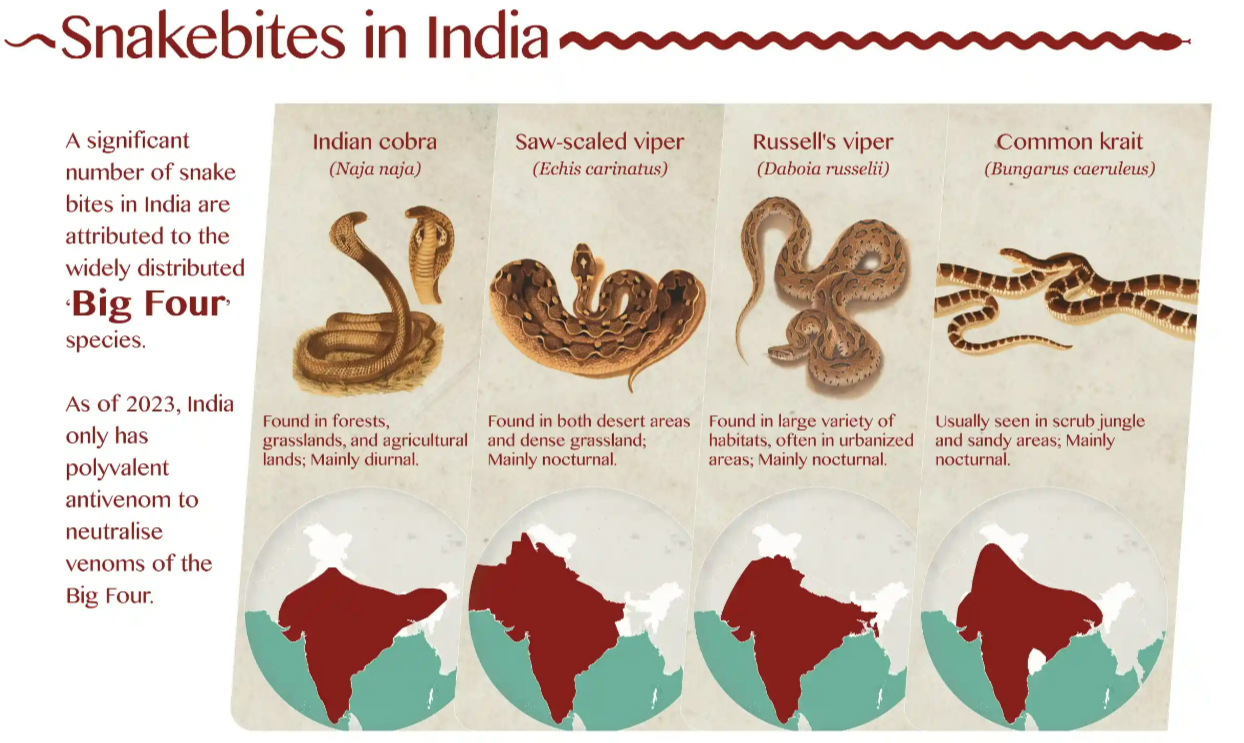Important Facts For Prelims
Snake Venom Neutralising Antibody
- 26 Feb 2024
- 5 min read
Why in News?
Researchers at the Indian Institute of Science (IISc) in Bengaluru have created a synthetic human antibody capable of neutralising a powerful neurotoxin produced by Elapidae snakes, such as the cobra, king cobra, krait, and black mamba.
- Elapids, a diverse family of venomous snakes, have hollow, front fangs that deliver venom and include 300 species across various habitats globally.
What is the New Venom-Neutralising Antibody?
- About:
- Methodology:
- The team's antibody targets a conserved region in the core of the three-finger toxin (3FTx) found in elapid venom, despite variations in this toxin among different elapid species.
- The researchers tested their synthetic antibody on animal models, finding it effective against toxins from the Taiwanese banded krait, monocled cobra, and black mamba, with a potency nearly 15 times that of conventional antivenom, even when administered after a delay following venom injection.
- Conventional antibodies are not uniform in their composition, as they are a mixture of different types of molecules with varying affinity and specificity to different epitopes of the antigen that triggered their production.
- Need:
- Snakebites cause thousands of deaths annually, particularly in India and sub-Saharan Africa.
- According to an Indian Council of Medical Research (ICMR) study, India has witnessed approximately 1.2 million (12 lakh) snakebite fatalities between 2000 and 2019, averaging 58,000 deaths annually.
- India accounts for almost 50% of global snakebite deaths.
- The World Health Organization (WHO) classified snakebite envenoming as a neglected tropical disease of high priority.
- Snakebites cause thousands of deaths annually, particularly in India and sub-Saharan Africa.
- Application:
- Researchers suggest that this advancement brings us closer to a universal antibody solution capable of providing broad protection against various snake venoms.
Other Initiatives to Prevent Snake Bite:
- Much before the WHO roadmap was launched, researchers from the ICMR started community awareness and health system capacity building from the year 2013.
- In alignment with WHO's Snakebite Envenoming Strategy and the United Nations' Sendai Framework for Disaster Risk Reduction, India ratified a National Action Plan in 2015 to combat this issue.
- The 2022-2030 Regional Action Plan for snakebite envenoming in South-East Asia aims to halve snakebite-related deaths and disabilities by 2030, aligning with the Global Strategy, and seeks to guide Member States, WHO, donors, and partners in strengthening health systems and accelerating actions at the human-animal-ecosystem interface through various strategies and priority areas.
UPSC Civil Services Examination, Previous Year Questions (PYQs)
Prelims
Q 1. Consider the following statements: (2019)
- Some species of turtles are herbivores.
- Some species of fish are herbivores.
- Some species of marine mammals are herbivores.
- Some species of snakes are viviparous.
Which of the statements given above are correct?
(a) 1 and 3 only
(b) 2, 3, and 4 only
(c) 2 and 4 only
(d) 1, 2, 3 and 4
Ans: (d)
Q 2. King Cobra is the only snake that makes its own nest. Why does it make its nest? (2010)
(a) It is a snake-eater and the nest helps attract other snakes
(b) It is a viviparous snake and needs a nest to give birth to its offspring
(c) It is an oviparous snake and lays its eggs in the nest and guards the nest until they are hatched
(d) It is a large, cold-blooded animal and needs a nest to hibernate in the cold season
Ans: (c )
Q 3. For which one of the following snakes is the diet mainly composed of other snakes? (2008)
(a) Krait
(b) Russell’s viper
(c) Rattlesnake
(d) King Cobra
Ans: (d)





